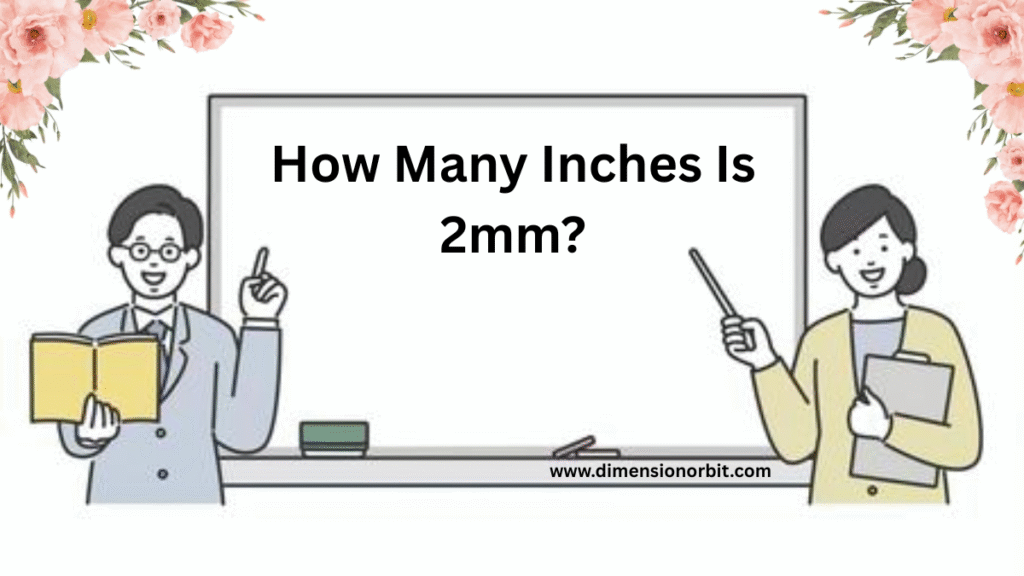Ever tried to picture how big is 2mm and ended up squinting at a ruler like it was a magic eye puzzle? You’re not alone. Two millimeters is one of those measurements that sounds laughably tiny until you realize it can make your phone case fit perfectly or ruin a DIY project faster than you can say “oops.” It’s small enough to hide under your fingernail, yet big enough to change how your gadgets, jewelry, and jeans fit. In this guide, we’ll shrink the mystery down to size with real life examples that make 2 mm feel hilariously and surprisingly important.
What Is a Millimeter?

A millimeter (mm) is one thousandth of a meter the smallest common unit in the metric system.
Here’s how it fits into the big picture:
| Metric Unit | Equivalent in Millimeters | Description |
|---|---|---|
| 1 meter | 1000 mm | Length of a baseball bat |
| 1 centimeter | 10 mm | Width of your fingernail |
| 2 mm | — | About the thickness of two stacked dimes |
Two millimeters might sound tiny, but it’s surprisingly visible to the naked eye. You can spot a 2 mm line on any metric ruler; it’s just two small marks from zero.
How Long Is 20 Inch? 12 Common Things
How Many Inches Is 2mm?

Now for the 2 mm to inches conversion because many people think in inches instead of millimeters.
- 1 mm = 0.03937 inches
- 2 mm = 0.07874 inches
That’s just a hair under 1/13 of an inch, or roughly the thickness of a heavy guitar string.
So when you hear “2 mm,” imagine something about 0.08 inches thick small, but absolutely measurable.
Why Visualizing 2mm Matters

Humans aren’t great at estimating micro measurements. We rely on comparison. When you connect a number like 2 mm to an object you recognize, you can grasp its scale instantly.
Consider these real life scenarios:
- A jeweler uses 2 mm gemstones to design minimalist earrings.
- A builder leaves a 2 mm gap between tiles for perfect alignment.
- A smartphone designer adjusts the screen glass thickness by 2 mm for better durability.
Once you visualize 2 mm, these details stop being abstract and start feeling tangible.
How Tall Is 66 Inches? 10 Common Things
2mm Size Comparison 11 Real Objects You Can Visualize
Here are eleven everyday objects that measure about 2mm in width, diameter, or thickness. These comparisons bring that tiny number to life.
| Object | Approx Measurement | Description / Visualization |
|---|---|---|
| Sesame Seed | 2 mm wide | Tiny yet visible; easy kitchen reference. |
| Two Stacked Dimes | 2 mm thick (total) | Each dime 1 mm; together ≈ 2 mm. |
| Paperclip Wire | 2 mm diameter | Standard office clip wire gauge. |
| Grain of Rice | 2 mm thick | Especially short or medium grain rice. |
| Standard Guitar String (B String) | 1.9–2.1 mm | Used on acoustic guitars; matches 2 mm exactly. |
| Small Gemstone (Earring Stud) | 2 mm diameter | Common in minimalist jewelry designs. |
| Stack of 20 Printer Sheets | 2 mm | Each sheet 0.1 mm thick. |
| Mechanical Pencil Lead | 2 mm type | Architects often use 2 mm leads for sketching. |
| Smartphone Screen Glass | 1.8–2.2 mm | Typical for tempered phone displays. |
| Small Ant’s Body Width | 2 mm | Tiny but visible under natural light. |
| SD Card Plastic Shell | 2 mm thick | Common tech item you probably own. |
Each example provides a real world anchor for your imagination. You can literally see and feel 2 mm once you relate it to things you handle every day.
Pringles Can Dimensions Size,Height & Everything
What Does 2mm Look Like?

To visualize 2 mm:
- Look at a metric ruler two small ticks past zero.
- Stack 20 pieces of printer paper; that’s almost exactly 2 mm.
- Notice the thickness of your smartphone’s glass edge again, right around that mark.
So yes, you can definitely see 2 mm with the naked eye. You just need a reference point.
Practical Importance of 2mm in Different Fields
Even though 2 mm sounds minuscule, it can make or break precision in many industries.
Fashion & Jewelry
- Tiny gemstones (1.5–2 mm) are used in delicate stud earrings and micro-pavé rings.
- Earring posts themselves are often 2 mm thick, balancing durability with comfort.
“In jewelry design, a 2 millimeter variation can change the entire aesthetic of a piece.” M. Delaney, Gemological Institute of America
Technology & Engineering
- Smartphone screen glass: typically 1.8–2.2 mm thick for strength without bulk.
- Circuit board layers and microchips depend on millimeter precision even a 2 mm error can cause short circuits.
- USB and headphone connectors rely on tight 2–3 mm tolerances to ensure snug fits.
Construction & Manufacturing
- Tile spacing, grout gaps, and gasket seals often use 2 mm standards.
- A misalignment greater than 2 mm can lead to leaks, uneven surfaces, or structural flaws.
- In metal fabrication, ±2 mm tolerance defines precision grades.
Science & Medicine
- Microsurgical tools, hypodermic needles, and implant components are often specified down to millimeters.
- Human fingernails grow about 2 mm each month, a fun biological reference point.
These examples prove 2 mm isn’t trivial it’s functional accuracy in action.
How to Measure 2mm Accurately
Tools You Can Use
- Metric Ruler The simplest way; 2 mm equals two tiny divisions past zero.
- Vernier Caliper Measures internal and external distances with sub-millimeter accuracy.
- Digital Micrometer Ideal for engineers and jewelers when ±0.01 mm precision matters.
Tip: Always ensure your measuring surface is clean; dust or bent edges can distort readings by nearly a millimeter.
Estimating 2mm Without Tools
Need to eyeball 2 mm? Try these tricks:
- Two credit cards stacked 1.8–2 mm.
- 2 mm mechanical pencil lead visibly accurate gauge.
- Sesame seed width surprisingly close to exact.
These quick methods aren’t lab-accurate, but they’re great for a visual estimate.
2mm Conversion Chart
| Metric | Imperial | Everyday Comparison |
|---|---|---|
| 1 mm | 0.039 in | Thickness of a dime |
| 2 mm | 0.079 in | Two stacked dimes |
| 5 mm | 0.197 in | Pencil eraser diameter |
| 10 mm | 0.394 in | Width of a fingernail |
| 25 mm | 0.984 in | About one inch |
This simple metric conversion chart helps bridge the mental gap between millimeters and inches.
Real Life Case Study When 2mm Matters

A well known case from the automotive industry involved a gear housing misalignment of just 2 millimeters. That tiny discrepancy caused excessive vibration, forcing a recall worth millions.
It’s a stark reminder: even the smallest unit can have major consequences.
Another example: in architecture, a miscalculation of 2 mm in tile spacing can cause an entire pattern to drift by centimeters over a few feet of wall. Precision adds up fast.
Fun Facts About 2 Millimeters

- A 2 mm rainfall is just a light drizzle it’ll dampen the pavement but not flood your garden.
- Bird feathers can measure around 2 mm thick at the shaft.
- Paper currency thickness varies by country but often falls between 0.1–0.2 mm, meaning a stack of ten bills is close to 2 mm.
- Hair vs 2 mm: The average human hair is 0.06–0.1 mm thick so 2 mm equals roughly 20–30 strands of hair side by side.
Challenges of Working With 2mm Precision

Working with such small measurements requires focus. Here’s why it’s tricky:
- Human error: Even steady hands can’t reliably mark within ±1 mm without tools.
- Tool resolution: Basic rulers lack sub-mm accuracy.
- Material flex: Heat, humidity, or pressure can cause 2 mm deviations in metal or wood.
Pro Tip: Professionals use digital calipers or optical scanners to avoid these pitfalls.
In fields like aerospace or medicine, maintaining ±0.5 mm tolerances can mean the difference between success and failure.
Everyday Applications of 2mm
Let’s bring this back to your daily life places where 2 mm measurements sneak in unnoticed:
- Eyeglasses: Lens thickness and bridge width often vary by just a couple millimeters.
- Smart gadgets: Button travel and case gaps are fine-tuned to around 2 mm for comfort and usability.
- DIY Projects: Woodworkers and 3D printing enthusiasts regularly measure to the millimeter to ensure precise joints.
- Stationery: A standard ballpoint pen tip is about 1–2 mm in diameter, perfect for comparison.
Knowing these small measurements makes you more confident when building, fixing, or buying anything that lists size specs.
Is 2mm Big or Small? Let’s Put It in Perspective
“Big” or “small” depends entirely on context:
- For jewelry: 2 mm is small delicate, subtle, and minimalist.
- For electronic circuits: 2 mm is huge a gap that can ruin conductivity.
- For hair or fibers: 2 mm is massive.
- For construction: 2 mm is within tolerance but still visible.
So yes, it’s tiny, but not microscopic. You can always see and feel 2mm without tools.
How to Visualize 2mm Quickly
If you ever need a mental shortcut:
- Picture a sesame seed that’s roughly 2 mm wide.
- Think of two stacked dimes together they’re 2 mm thick.
- Recall your phone’s screen glass edge almost exactly 2 mm.
- Imagine 20 sheets of paper their combined thickness is 2 mm.
You’ll never forget that number again.
Key Takeaways
- 2 mm = 0.0787 inches = 0.2 centimeters.
- It’s visible, measurable, and common in hundreds of everyday items.
- Precision at this scale matters in jewelry, tech, construction, and medicine.
- You can visualize it easily using familiar objects like sesame seeds, pencil leads, and phone screens.
Digital tool
Digital tools like Feet and Inches Calculator can convert inches to centimeters or feet instantly. Many smartphone apps now offer augmented reality measuring features, allowing you to gauge objects virtually and compare them to known lengths.
FAQs
What does 2mm look like in real life?
2 mm looks roughly like the width of a sesame seed or the diameter of a pencil lead. You can also picture two stacked dimes that’s almost exactly 2 millimeters thick.
Can you see 2mm with the naked eye?
Yes, absolutely. Most people can easily spot something that’s 2 mm wide without a magnifying glass. It’s small, but definitely visible.
How thick is 2 mm in inches?
2 mm equals about 0.0787 inches, or just under one-thirteenth of an inch. That’s about the same as the thickness of a heavy guitar string or 20 sheets of printer paper stacked together.
Is 2 mm thick or thin?
It depends on context. For jewelry or glass, 2mm is thin and delicate. But in precision work or construction, a 2mm difference can be huge sometimes the line between perfect and “back to the drawing board.”
What are some everyday objects that are 2 mm thick?
Some quick examples include:
- A sesame seed
- Two stacked dimes
- A smartphone’s glass screen
- A mechanical pencil lead
- A paperclip wire
How can I measure 2 mm without a ruler?
Try using things around you:
- Stack two credit cards (around 1.8–2 mm thick together)
- Look at a 2 mm pencil lead
- Compare to a sesame seed’s width
These make handy visual guides when you don’t have measuring tools nearby.
Is 2mm a lot in measurements?
In everyday life, not really it’s tiny. But in engineering, watchmaking, or surgery, being off by even 2 mm can cause serious issues. Precision makes that small number a big deal.
How long is 2mm compared to hair?
The average human hair is about 0.06–0.1 mm thick, so 2 mm equals roughly 20–30 strands of hair laid side by side.
Why does 2mm matter so much?
Because in many designs, tolerances are tight. A 2mm gap might make jewelry uncomfortable, prevent a screw from fitting, or cause a machine part to fail. Tiny differences, big outcomes!
What’s 2mm in centimeters and meters?
Simple conversions:
- 2 mm = 0.2 cm
- 2 mm = 0.002 m
Final Thoughts
So, how big is 2mm?
It’s small yet surprisingly powerful once you understand it. Two millimeters may seem insignificant until you see how often it shapes the world around you. From the thickness of your phone’s screen glass to the precision of a surgeon’s tool, 2mm defines accuracy, design, and detail.
Think about it: a gap that small can make jewelry comfortable, a machine run smoother, or a construction project fail. Once you start recognizing 2 mm in everyday life in a sesame seed, a guitar string, or a stack of paper you’ll realize that this “tiny” measurement isn’t trivial at all.
So next time someone mentions 2mm, picture it clearly. It’s a sliver of space that balances beauty, precision, and practicality proof that even the smallest things can make the biggest difference.

Jhon AJS, the author of Dimension Orbit, is an experienced blogger fascinated by the mysteries of existence. He explores every type of dimension from scientific to spiritual with clarity and creativity. Jhon’s engaging writing style invites readers to think deeper, question reality, and discover new perspectives on the universe.






